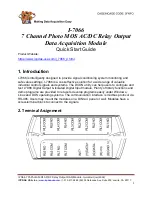
12
3.2
Attachment Points
3.2.1
Prior to attaching the hoist ensure that all attachment points, suspension
components and supporting structure are adequate to support the hoist and its load. If necessary
consult a professional that is qualified to evaluate the adequacy of the suspension location and its
supporting structure.
3.2.2
See
Section 6.6 for outdoor installation considerations.
3.3
Mounting the Hoist
3.3.1
Hook Mounted to a Fixed Location -
Attach the hoist’s top hook to the fixed suspension point.
3.3.2
Ensure that the fixed suspension point rests on the center of the hook’s saddle and
that the hook’s latch is engaged.
3.4
Preoperational Checks and Trial Operation
3.4.1
Confirm the adequacy of the rated capacity for all slings, chains, wire ropes and all
other lifting attachments before use. Inspect all load suspension members for damage prior to use and
replace or repair all damaged parts.
3.4.2
Verify and correct all chain irregularities prior to operating the hoist. Refer to
Section 3.1.
3.4.3
Measure and record the “k” dimension of all hooks on hoist. See Table 5-4 under Section 5,
“Inspection”.
3.4.4
Record the hoist's Code, Lot and Serial Number (from the name plate on the hoist; see Section 9) in
the space provided on the cover of this manual.
3.4.5
Ensure that the hoist is properly installed to a fixed point.
3.4.6
Ensure that all nuts, bolts and split pins (cotter pins) are sufficiently fastened.
3.4.7
Confirm proper operation.
Before operating read and become familiar with Section 4 - Operation.
Before operating ensure that the hoist meets the Inspection, Testing and Maintenance
requirements of ANSI/ASME B30.16.
Before operating ensure that nothing will interfere with the full r
ange of the hoist’s operation.
Summary of Contents for CF005
Page 41: ...41 This Page Intentionally Left Blank...
Page 43: ...43 9 1 1 2 to 5 Parts Figure 9 2 1 2 to 5 Ton Parts...
Page 49: ...49 NOTES...
Page 50: ...50 NOTES...
Page 51: ...51 NOTES...













































